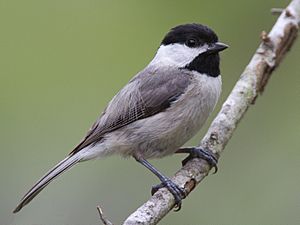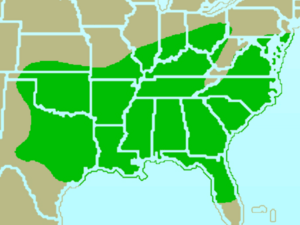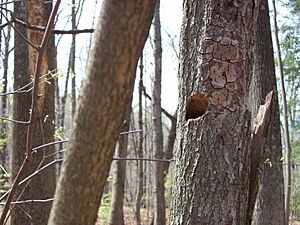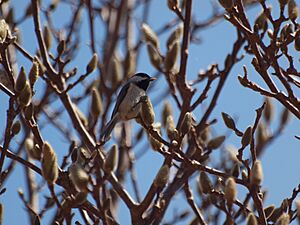Carolina chickadee facts for kids
Quick facts for kids Carolina chickadee |
|
|---|---|
 |
|
| Conservation status | |
| Scientific classification | |
| Genus: |
Poecile
|
| Species: |
carolinensis
|
 |
|
| Range of P. carolinensis | |
| Synonyms | |
|
Parus carolinensis |
|
The Carolina chickadee (Poecile carolinensis) is a small songbird. It belongs to the tit family, called Paridae. These birds are known for their lively nature. They are often seen in forests across the southeastern United States.
Contents
What Does a Carolina Chickadee Look Like?
Adult Carolina chickadees are about 11.5 to 13 centimeters (4.5 to 5 inches) long. They weigh between 9 and 12 grams (0.3 to 0.4 ounces). They have a black cap on their head and a black patch under their chin, like a bib. Their cheeks are white. Their belly is white, with a little bit of rusty brown on their sides. Their back is grey. They have a short, dark beak and a medium-length tail.
Carolina chickadees look very much like the black-capped chickadee. You can tell them apart by looking closely at their wings. Carolina chickadees have slightly browner wings. Their tail is also a bit shorter and more square-shaped.
How Do Carolina Chickadees Communicate?
Carolina chickadees are famous for their calls. Their most well-known call sounds like "chick-a-dee-dee-dee." This call is how they got their name! Their song is a clear, four-note sound: "fee-bee-fee-bay."
It can be tricky to tell Carolina chickadees from black-capped chickadees by their calls. The Carolina chickadee's "chick-a-dee" call is faster and higher-pitched. Their song is different too. Black-capped chickadees usually sing a two-note song. Carolina chickadees sing a four-note song.
Sometimes, these two types of chickadees mate where their living areas overlap. This can create mixed-species birds. These mixed birds might sing a three-note song.
Where Do Carolina Chickadees Live?

Carolina chickadees live in mixed forests or woods with deciduous trees. These are trees that lose their leaves in the fall. You can find them in the United States. Their range stretches from New Jersey west to southern Kansas. It goes south to Florida and Texas.
They build their nests in holes in trees. Both the male and female chickadee help dig out the nest. They might use a natural hole or an old woodpecker nest.
These birds usually stay in the same area all year. They do not fly south for the winter, even when the weather gets very cold.
What Do Carolina Chickadees Eat?
Carolina chickadees are busy eaters! They hop along tree branches looking for insects. Sometimes they hang upside down to find food. They might even fly short distances to catch insects in the air. Insects are a big part of their diet, especially in summer.
In winter, they eat more seeds and berries. They sometimes hit seeds against a tree to open them. They also hide seeds to eat later. This is called storing food.
During fall and winter, chickadees often fly together in groups. Many other birds, like titmice, nuthatches, and warblers, join these groups. The chickadees call out when they find good food. This helps the whole group find food more easily.
How Do Carolina Chickadees Stay Warm?
Carolina chickadees have a special way to stay warm in very cold winters. They can lower their body temperature on purpose. This state is called torpor. It helps them save energy.
When it's extremely cold, they find small holes or cavities to hide in. They can stay in torpor for up to fifteen hours. During this time, they are awake but very still. It's important not to disturb them when they are in torpor. Being handled could stress them out and harm them.
Images for kids
See also
 In Spanish: Carbonero de Carolina para niños
In Spanish: Carbonero de Carolina para niños







